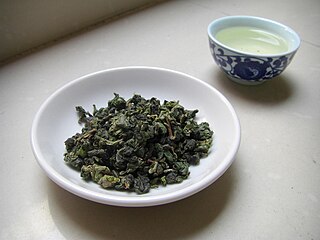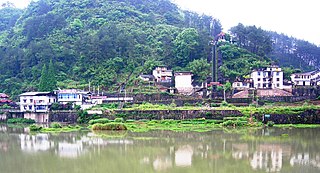
Oolong is a traditional semi-oxidized Chinese tea produced through a process that includes withering the leaves under strong sun and allowing some oxidation to occur before curling and twisting. Most oolong teas, especially those of fine quality, involve unique tea plant cultivars that are exclusively used for particular varieties. The degree of oxidation, which is controlled by the length of time between picking and final drying, can range from 8% to 85% depending on the variety and production style. Oolong is especially popular in southeastern China and among ethnic Chinese in Southeast Asia, as is the Fujian preparation process known as the gongfu tea ceremony.

Cabernet Sauvignon is one of the world's most widely recognized red wine grape varieties. It is grown in nearly every major wine producing country among a diverse spectrum of climates from Australia and British Columbia, Canada to Lebanon's Beqaa Valley. Cabernet Sauvignon became internationally recognized through its prominence in Bordeaux wines, where it is often blended with Merlot and Cabernet Franc. From France and Spain, the grape spread across Europe and to the New World where it found new homes in places like California's Napa Valley, New Zealand's Hawke's Bay, South Africa's Stellenbosch region, Australia's Margaret River, McLaren Vale and Coonawarra regions, and Chile's Maipo Valley and Colchagua. For most of the 20th century, it was the world's most widely planted premium red-wine grape until it was surpassed by Merlot in the 1990s. However, by 2015, Cabernet Sauvignon had once again become the most widely planted wine grape, with a total of 341,000 hectares (3,410 km2) under vine worldwide.

Lapsang souchong or Zhengshan xiaozhong is a black tea consisting of Camellia sinensis leaves that are smoke-dried over a pinewood fire. This smoking is accomplished either as a cold smoke of the raw leaves as they are processed or as a hot smoke of previously processed leaves. The intensity of the smoke aroma can be varied by locating the leaves closer or farther from the source of heat and smoke or by adjusting the duration of the process. The flavour and aroma of smoked lapsang souchong is described as containing empyreumatic notes, including wood smoke, pine resin, smoked paprika, and dried longan; it may be mixed with milk but is not bitter and usually not sweetened with sugar. The tea originates from the Wuyi Mountains region of Fujian and is considered a Wuyi tea. It is also produced in Taiwan. It has been labelled as smoked tea, smoky souchong, tarry lapsang souchong and lapsang souchong crocodile. While the tea leaf grading system adopted the term souchong to refer to a particular leaf position, lapsang souchong may be made with any leaf of the Camellia sinensis plant, though it is not unusual for the lower leaves, which are larger and less flavourful, to be used as the smoking compensates for the lower flavour profile and the higher leaves are more valuable for use in unflavoured or unblended teas. In addition to its consumption as a tea, lapsang souchong is also used in stock for soups, stews and sauces or otherwise as a spice or seasoning. Beginning in the early 21st century, an unsmoked variety of lapsang souchong was developed in the village of Tong Mu Guan in the Wuyi mountains. The unsmoked variety has become increasingly popular, particularly in the Chinese domestic market.

Earl Grey tea is a tea blend which has been flavoured with oil of bergamot. The rind's fragrant oil is added to black tea to give Earl Grey its unique taste. However, many if not most Earl Greys use artificial bergamot flavour.

Pu'er or pu-erh is a variety of fermented tea traditionally produced in Yunnan Province, China. In the context of traditional Chinese tea production terminology, fermentation refers to microbial fermentation, and is typically applied after the tea leaves have been sufficiently dried and rolled. As the tea undergoes controlled microbial fermentation, it also continues to oxidize, which is also controlled, until the desired flavors are reached. This process produces tea known as hēichá (黑茶), literally "black tea", though the term is commonly translated to English as "dark tea" to distinguish it from the English-language black tea, which it is not.

Keemun is a famous Chinese black tea. First produced in the late 19th century, it quickly became popular in the West and is still used for a number of classic blends. It is a light tea with characteristic stone fruit and slightly smoky notes in the aroma and a gentle, malty, non-astringent taste reminiscent of unsweetened cocoa. Keemun is said to have floral aromas and wooden notes.

Tieguanyin is a variety of Chinese oolong tea that originated in the 19th century in Anxi in Fujian province. Tieguanyin produced in different areas of Anxi have different gastronomic characteristics.

The Drake, a Hilton Hotel, 140 East Walton Place, Chicago, Illinois, is a luxury, full-service hotel, located downtown on the lake side of Michigan Avenue two blocks north of the John Hancock Center and a block south of Oak Street Beach at the top of the Magnificent Mile. Overlooking Lake Michigan, it was founded in 1920, and soon became one of Chicago's landmark hotels and a longtime rival of the Palmer House.

Hong Kong–style milk tea, also known as "silk-stocking" milk tea (絲襪奶茶), is a tea drink made from Ceylon black tea and evaporated milk. The drink originated in the mid-20th century during the British rule of Hong Kong, and was inspired by the British's afternoon tea.

Tea culture is how tea is made and consumed, how people interact with tea, and the aesthetics surrounding tea drinking.

Dianhong tea is a type of relatively high-end, gourmet Chinese red tea sometimes used in various tea blends and grown in Yunnan Province, China. The main difference between Dianhong and other Chinese red teas is the amount of fine leaf buds, or "golden tips," present in the dried tea. Dianhong tea produces a brew that is brassy golden orange in colour with a sweet, gentle aroma and no astringency. Cheaper varieties of Dianhong produce a darker brownish brew that can be very bitter.

Tea blending is the act of blending different teas to produce a final product that differs in flavor from the original tea used. This occurs chiefly with black tea, which is blended to make most tea bags, but it can also occur with such teas as Pu-erh, where leaves are blended from different regions before being compressed. The most prominent type of tea blending is commercial tea blending, which is used to ensure consistency of a batch on a mass scale so that any variations between different batches and seasons of tea production do not affect the final product. Commercially, it is considered important that any batch of a particular blend must taste the same as the previous batch, so a consumer will not be able to detect a difference in flavor from one purchase to the next.

English breakfast tea or simply breakfast tea is a traditional blend of black teas originating from Assam, Ceylon and Kenya. It is one of the most popular blended teas, common in indigenous British and Irish tea culture, which developed among native populations since their exposure to Asian tea culture.

Irish breakfast tea is a blend of several black teas, most often a combination of Assam teas and Ceylon teas. Irish tea brands, notably Barry's, Bewley's, Lyons and Robert Roberts in the Republic and Nambarrie's and Thompson's Punjana in Northern Ireland are heavily weighted towards Assam. It is one of the most popular blended teas, common in tea culture in Ireland. When tea was first transported from China to Ireland in the mid-18th century, it was mainly introduced to the wealthy as a result of its high cost and low demand. However, throughout the mid-19th century, Irish breakfast tea became readily available to those of both lower and higher socioeconomic classes.

Qimen County is a county in the southeast of Anhui Province, China, bordering Jiangxi Province to the southwest. It is the westernmost county-level division of the prefecture-level city of Huangshan City. It has a population of 190,000 and an area of 2,257 square kilometres (871 sq mi). The government of Qimen County is located in Qishan Town.
Russian Caravan is a blend of oolong, keemun, and lapsang souchong teas. It is described as an aromatic and full-bodied tea with a sweet, malty, and smoky taste. Some varieties do not include lapsang souchong, and thus have a less smoky flavor, while others include assam tea. Traditionally the smoky character was considered to have been imparted to the tea by the close proximity of the camel caravans to countless camp fires en route across the Mongolian Steppes to Russia.

India is the second largest producer of tea in the world after China, including the famous Assam tea and Darjeeling tea. Tea is the 'State Drink' of Assam. Following this the former Planning Commission Deputy Chairman, Montek Singh Ahluwalia had plans to officially recognise tea as the Indian "National Drink" in 2013. According to the ASSOCHAM report released in December 2011, India is the world's largest consumer of tea, consuming nearly 30% of global output. India is also the second-largest exporter of tea, after China.
Tea is a major cash crop that is grown in Kenya. Kenyan tea has been the leading major foreign exchange earner for the country.

Black tea is a type of tea that is more oxidized than oolong, yellow, white, and green teas. Black tea is generally stronger in flavour than other teas. All five types are made from leaves of the shrub Camellia sinensis, though Camellia taliensis is also rarely used.
















